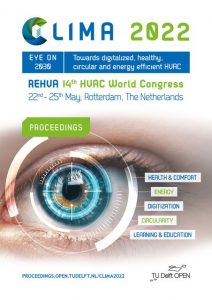Clima 2022 Conference paper on passive cooling techniques to improve resilience of nZEBs in Belgium
 Nowadays, buildings are responsible for 40% of energy consumption in the European Union, according to the International Energy Agency (IEA). The urge to build more energy-efficient buildings resulted in the emergence of nearly zero-energy buildings (nZEB). However, the specifications the nZEB design should comply with might not be sufficient to prevent the risk of overheating in summer. To limit the energy consumption rise linked to the upcoming cooling demand increase, passive cooling techniques can be used instead of active ones, that are characterised by a high energy consumption. Passive cooling techniques are investigated through a dynamic simulation of a nearly zero-energy dwelling in Belgium. Their efficiency is assessed based on their ability to improve thermal comfort. The passive cooling techniques can be combined to ensure the resilience of the building to global warming. It was found that the most efficient techniques are the ones relying on ventilative cooling. Solar protections and smart glazing also offer an efficient protection against overheating. The effectiveness of the combined passive cooling techniques is studied over an extreme meteorological event, which is likely to occur by 2100 in Belgium if nothing is done to prevent global warming. Twenty days of intense heat are studied to evaluate the resilience of an nZEB. It was found that the most efficient combination includes night cooling, thermochromic glazing and indirect evaporative cooling. Those techniques allow to decrease the indoor temperature by almost 10 K.
Nowadays, buildings are responsible for 40% of energy consumption in the European Union, according to the International Energy Agency (IEA). The urge to build more energy-efficient buildings resulted in the emergence of nearly zero-energy buildings (nZEB). However, the specifications the nZEB design should comply with might not be sufficient to prevent the risk of overheating in summer. To limit the energy consumption rise linked to the upcoming cooling demand increase, passive cooling techniques can be used instead of active ones, that are characterised by a high energy consumption. Passive cooling techniques are investigated through a dynamic simulation of a nearly zero-energy dwelling in Belgium. Their efficiency is assessed based on their ability to improve thermal comfort. The passive cooling techniques can be combined to ensure the resilience of the building to global warming. It was found that the most efficient techniques are the ones relying on ventilative cooling. Solar protections and smart glazing also offer an efficient protection against overheating. The effectiveness of the combined passive cooling techniques is studied over an extreme meteorological event, which is likely to occur by 2100 in Belgium if nothing is done to prevent global warming. Twenty days of intense heat are studied to evaluate the resilience of an nZEB. It was found that the most efficient combination includes night cooling, thermochromic glazing and indirect evaporative cooling. Those techniques allow to decrease the indoor temperature by almost 10 K.
The full paper is available for download on the World Congress CLIMA website.
